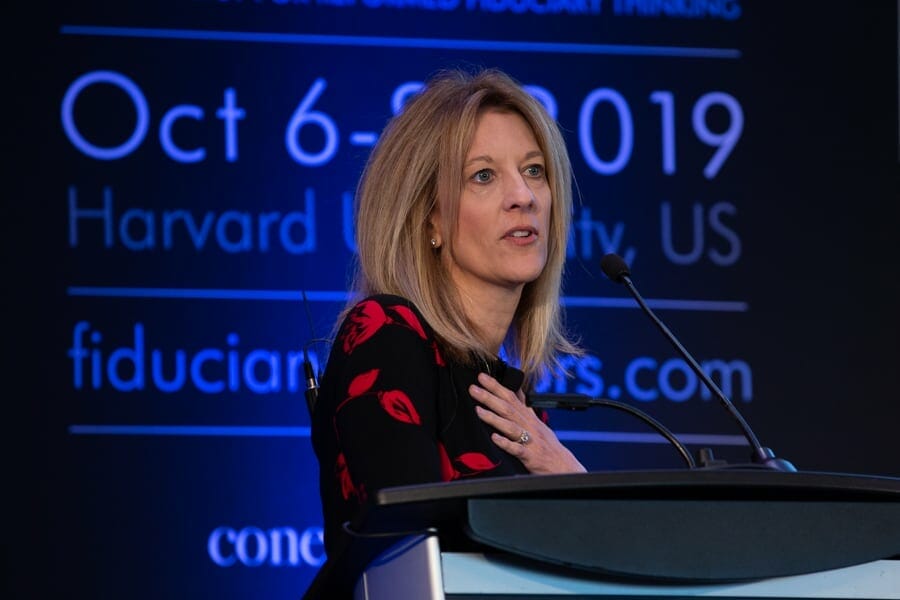The solution to slowing global growth lies in a new way of thinking, said Stephanie Kelton, a leading Modern Monetary Theory (MMT) scholar at Stony Brook University and senior economic advisor to presidential candidate, Senator Bernie Sanders. Today’s rock bottom interest rates and further rounds of QE show that Central Banks have run out of stimulus and policy levers, leaving them without ammunition ahead of the next recession. Monetary policy is no longer enough, and a more ambitious approach is needed.
“Let’s change the way we think. MMT asks you to reset your thinking,” she told delegates at the Fiduciary Investors Symposium at Harvard University.
MMT’s central premise is that governments are in control of issuing their currency – and can ultimately issue as much as they need.
“In the US, the Federal government has given unto itself the exclusive right to issue the dollar,” she said.
“This distinction changes everything because the issuer of a currency can’t go broke.”
As sole manufacturer of dollars, the US has a monopoly over issuance and can never run out or be left unable to pay bills, she said. This could manifest with the Federal government directly crediting companies to build infrastructure or aircraft carriers; universities to expand labs and fund research, or directly financing universal medicare and tuition fees.
Moreover, the government doesn’t have to tax or borrow to fund itself in this new expanded policy space. The idea of taxing people to pay for spending “leads down the wrong path.”
Instead, Congress is completely within its rights to write and pass budgets.
“Congress has the power of the purse,” she said. “What we are saying is that there is space available to us that we don’t take advantage of; we don’t run our economies at their full potential. We restrict the use of the fiscal policy lever.”
Speed limits
There are limits to this expanded policy space, however. They are not financial but are held in the real economy. Every internal economy has its own speed limit and can only go so fast, and produce so much, before inflation kicks-in. Currency issuers must therefore recognise how much fiscal space they have and not push too far, she said.
“The relevant constraint is inflation, not solvency. Governments should recognise the limits are real and respect them.”
Next, she expanded on the other central pillar to MMT thinking whereby governments don’t tax to spend. She told delegates that taxes should be used not to fund the government, but to take money out of the economy to reduce inflationary pressure and reduce the income available to spend.
“It is about subtracting spending power because too much spending will lead to inflation. Taxes are a release valve.”
For example, in 2008 when the wheels came off the global economy, the US government had capacity to spend much more.
“Everyone understood there was enough slack in the economy to absorb more spending without the need to put up taxes,” she said.
In contrast, today there is more of a debate about how much slack there is in the economy, and if spending would trigger inflation and merit tax increases.
“Would some portion of that spending need to be off-set by raising taxes to mitigate inflation risk? The debate changes as an economy moves from slack to less slack,” she said, adding that this was not new thinking. Back in the 1940s policy makers said taxing for revenue was “obsolete.”
Deficit shame
There is no irresponsibility to running a budget deficit. “My deficit is your surplus,” she said, explaining that the surplus is there because of the “government’s generosity in running a fiscal deficit.” As government deficits increase, and the negative number grows, so the private sector’s balance sheet gets bigger. For example, the government deficit exploded after the financial crisis, producing a surplus that allowed the financial sector to repair its balance sheet. “The recovery took longer where this didn’t happen,” she said.
Deficits require borrowing that adds to the national debt over time, but under MMT thinking if governments are in charge of their currency issuance – and are issuing in their own currency – it is not a problem.
“National debt is nothing more than a historical record of what governments have spent and taxed away,” she said.
Today, political discourse around the concept of national debt scares people, and it would be easier to swallow if it wasn’t labelled debt. “I want people to see a headline that national debt is at an all-time high but take a breath and know that it is ok,” she said, warning that the process should never be referred to as printing money.
Balanced Economy
The goal under MMT thinking is a balanced economy, not a balanced budget. “MMT says focus on the proper outcome,” she says. If inflation creeps higher, governments will know they have spent too much.
“If the economy can handle [additional spending] without inflation, what is the problem?” If a government spends more than it collects, that does not make it fiscally irresponsible.
In another seam of thought, MMT sees trade in real resource terms. “If you get cars in exchange for wheat you are not getting killed,” she said, in reference to President Trump’s lambasting of Japan for its unfair trade with the US. According to MMT thinking, this is infact a good deal. The idea is to send abroad what we can’t use, and the gain is what we import, she explained. “It is favourable when you gain more by sending out less,” she said. “We are taking more of their stuff than what they are taking of ours.”
Referencing pension deficits, she said the government was in a position to ensure “cheques were always mailed out” and that in accordance with MTT thinking any deficit was “not the issue.” More important is how you build an economy that assures that real assets are created so that pensioners can keep spending.
“Our demographics are changing and that is leaving behind a smaller population of people producing.”
Now the onus should be on creating a system that ensures enough real assets to allow continued spending without causing an inflationary spike.
“If you want to make university tuition free, if you want to spend on infrastructure and universal medicare, it is a question of whether you have the real resource capacity to handle that new spending with contractors, access to steel, architects and professors. This is what matters. These are our real resources.”
See also: The dangers of MMT: a counter argument



